A Month in the Field in Baja California Sur: Part II
Part II — “Rancho Chivato, Sierra de las Cacachilas”
Botany Team Colleagues:
- Dr. Jon Rebman (SDNHM, San Diego Natural History Museum )
- John LaGrange (SDNHM)
- Dr. Alfonso Medel (CIBNOR, Centro de Investigaciones Biológicas del Noroeste)
- Dr. Jose Delgadillo (UABC Universidad Autónoma de Baja California)
- Dr. Jose Luis Leon de la Luz (CIBNOR)
- Dr. Reymundo Domínguez Cadena (CIBNOR)
- and several others! (Also in photo: Dr. Gorgonio Ruiz (UABC), and Dr. Alan Harper and Jim Riley of Terra Peninsular)

Oct 27th, Day 7, Sunday: RENEWED ENTHUSIASM
This morning Jon and John went early to the herbarium of CIBNOR (Centro de Investigaciones Biológicas del Noroeste) to confirm the identity of some rare plant specimens from the region we’ll be visiting for the next two weeks and to pick up colleague Dr. Alfonso Medel. Back at the hotel a chance to take a proper shower revealed insect bites all over my body and a serious saddle-rash from the mule trip. We had a spicy soup for breakfast that made my lips swell up, and I started to wonder if my body was going to hold up to another three weeks in the field! The internet was slow at the hotel, and attempting to catch up with the outside world was frustrating.
Taking advantage of a few hours in La Paz, Alan and I went to lunch with two colleagues from CIBNOR, Dr. Pedro Peña and Charlotte Gonzalez. Both have published widely on the biogeography of the peninsula of Baja California, producing maps of human impact, ecoregions, and distributions of leguminous trees, invasive species, and more. Conversation was animated and poured from topic to topic with no end of common interests. Sadly they can’t join us in the field during the coming weeks, but we discussed future collaborations with enthusiasm, and I felt my energy rejuvenated and renewed by the interaction. We reunited with the herbarium team and started the journey south to the Sierra de las Cacachilas.

The drive was dusty but gorgeous with a pink-orange sunset over the rolling hills of rich green vegetation sloping down to the ocean. We arrived at Rancho Chivato just after dark. The botany team is first to arrive at the base camp for the interdisciplinary expedition that will be taking place for the next two weeks. The ranch is spectacularly beautiful, with amazing views of Cerralvo Island, recently renamed to Jacques Cousteau Island in honor of the French explorer. I can’t wait to wake up tomorrow and start exploring. As we sit here at the table working on our respective laptops, tablets, and phones, the light has attracted a plethora of insects, including an enormous neuropteron (a monster netwing).
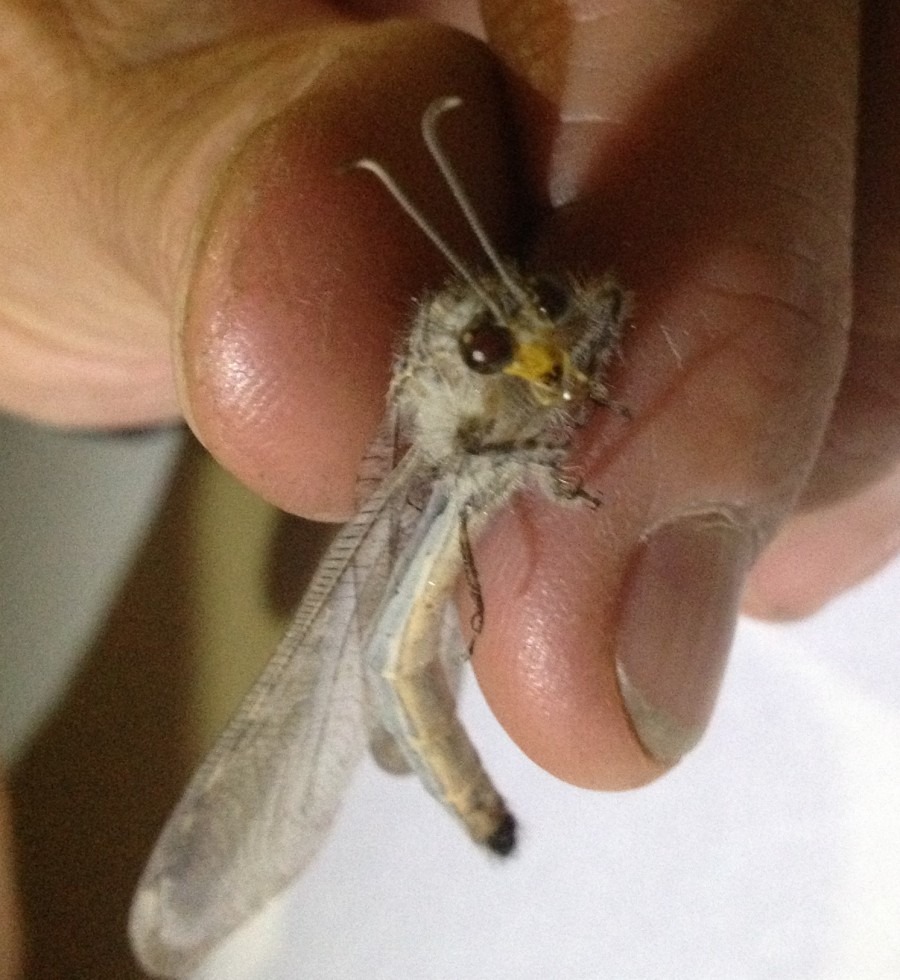
Oct 28th, Day 8, Monday: KISSING BUGS
The area is mega-diverse so we didn’t cover much ground today, but we did collect 57 plant species not previously collected in this area. We saw five species of succulent trees in the genus Bursera, all within less than a square kilometer, including the recently described B. rupicola. Every meter is packed full of unusual plants, almost all of which are new to me, so it’s been a lot of learning. Lots of things are still in flower and even more plants are in fruit, especially the large trees. Particularly delightful for me was the monotypic genus Carterella (having only one species, C. alexandrae), which is endemic (restricted) to the cape region of Baja California and is named after local botanist Annetta Carter (1907–1991) who spent a lot of time on mules botanizing this region. Another locally restricted genus of plants here is Stenotus, also in the coffee family (Rubiaceae), and we found two different species on the cliffs below the base camp.


One of the more interesting finds of the day was two floral forms of the subshrub Heliotropium cf. hintonii (this name has been applied to herbarium specimens from this region for a species originally described from the Chihauhuan desert, but we suspect it may be different). Some individuals had large flowers and very few fertile fruits, whereas others had small flowers and abundant fruits. We are hypothesizing that this is either a reproductive condition where the plants are imperfectly dioecious (separate male and female plants) or the smaller flowered individuals are self-pollinating and larger flowered individuals require cross pollination. We hope to gather more data on this while we’re here.
In the afternoon we took a hike up a dry canyon, and I found an insect I’d never seen before. Knowing that the entomology team was arriving tonight, I caught it in a sandwich bag and brought it back to show my colleagues. It turned out to be a cinche or kissing bug – a blood sucking true bug that typically feeds on rodents but has been known to bite humans (and transmit Chagas disease)! Everyone was highly amused that I had so proudly “caught” the bug that was trying to catch me.

Oct 29th, Day 9, Tuesday: CERRO LA TINAJA
We got up long before dawn, packed in the dark, and watched the most beautiful sunrise I’ve ever seen during breakfast. We then drove out to Remegio’s Corral, loaded our gear onto mules and donkeys, and made our way on foot to Cerro La Tinaja. It was a long walk, mostly because I’m just not used to walking in the heat and humidity. Around 1 pm we reached the saddle where we were to camp, and for 5 minutes I was able to take off my hot boots and gulp down some warm water and rest. The views from the top were again spectacular, this time looking out across Espiritu Santo Island and the vast inland valleys of the sierra. Plant treats for the day included the stunning red bulb, Behria tenuiflora, that was scattered along our footpath all day long. Also, the spiny succulent bromeliad Hechtia montana (Bromeliaceae) was present in large numbers near the summit, growing with large spiny century plants (Agave aurea) in the rocky cliff faces. The vegetation here is a fascinating mix of succulents and oak trees and many shrubs from Tropical Deciduous forests, some of which I recognize from trips to Sonora and Sinaloa. We collected several unusual grasses today, including one that Jon couldn’t even place to genus, which makes it something very special! Total collections for the day only number around 30, but all are gems of biodiversity, species never previously collected in the region, that add significantly to our knowledge of the Sierra Cacachila. Many of the species we are finding were only previously reported from the Sierra Laguna, so there are a lot of range extensions being documented on this expedition.

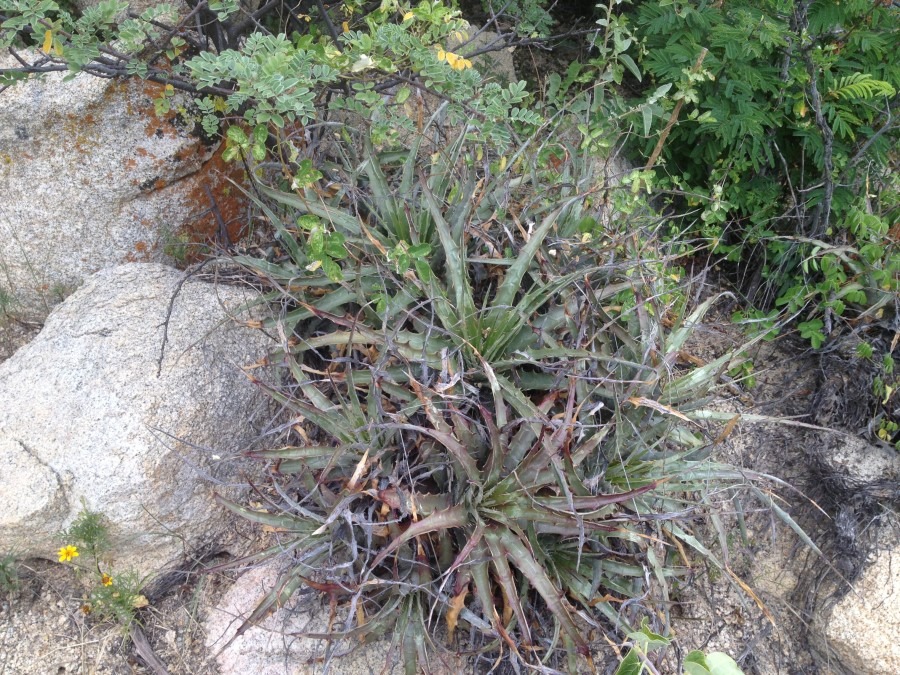
Amyris carterae is a funny-smelling plant in the Rutaceae that Jon described just a few years ago, although he thinks the plants here look slightly different. We are camping tonight with the bare minimum – actually with less than the bare minimum – as we appear to have no coffee for the morning. (Sigh…) For dinner we have some cold burritos, and we felt a long way from anywhere as the sun set yet again. Walking to the top of the nearest rock pile, there is cell phone service, and I’m able to check my email. Nowhere is truly remote anymore! Exhausted I’m in my sleeping bag and it’s only 7 pm.
Oct 30th, Day 10, Wednesday: FOGGED IN
The weather this morning appeared to be a blessing as we woke to a cool damp foggy sky, which made hiking to the high ridge a lot easier than it would have been in the heat of previous days. But as the day continued it got colder and colder until we were shivering and drenched with rain. Hiking the open slopes with our flower presses, we were soaked to the bone and there was no escaping the cold breeze that had been so delightful in the heat of yesterday. All our gear was wet — sleeping bags, field notes, and, worst of all, the press. Not only was it now very soggy, but also very heavy. The views were somewhat obscured by the fog, but some of the trees on the lower slopes really amazed me — plants I have only seen previously in cultivation, like the stunning Plumeria rubra, growing right next to my favorite street tree in California, Erythrina flabelliformis, the coral tree, which has large scarlet flowers and a beautiful growth form. I thought of my colleague Karen Hall at BRIT who does indigo workshops when we saw the wild indigo bush Indigofera fruticosa in abundance. Another surprise today was a small wet area with a rather inappropriately named “blue-eyed grass” with yellow flowers, which is actually an iris! (Sisyrinchium cernuum).

Our mystery plant for the day was a large vine in the morning-glory family (Convolvulaceae) which we look forward to identifying when back at the herbarium. We found a small snake hiding under a rock near the summit which we bagged and brought back for the herpetology team from the museum. Arriving back to base camp in the early evening, I was delighted to finally take a wash with a bucket of hot water. Lots of colleagues have now arrived to the expedition, from near and far, and we had a delicious hot meal with lots of laughter and enthusiasm, and a friendly tarantula joined us for dessert!

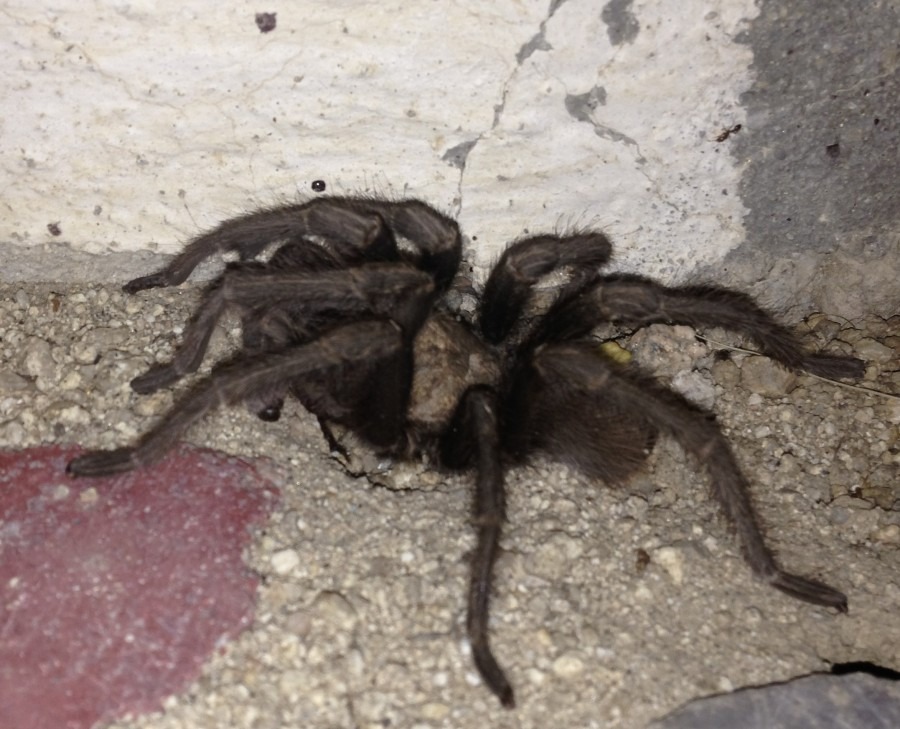
Oct 31st, Day 11, Thursday: CANYON CANOA
A slower start this morning gave me a chance to catch up on a couple of emails before we headed down to a large canyon in a big group. The herpetologists caught a large black snake called the Baja coachwhip which caused some excitement, and soon we were spread out all down the canyon — entomologists, botanists, herpetologists, mammologists, and ornithologists! It’s getting harder to find new species in the region, but there are still plenty of things that need good collections with flowers and/or fruits. There are little red-spotted toads everywhere, and every time we pass through a moist area tens of them emerge and start hopping in all directions. I even stepped on one by accident, bringing its life to a sad and sudden end.
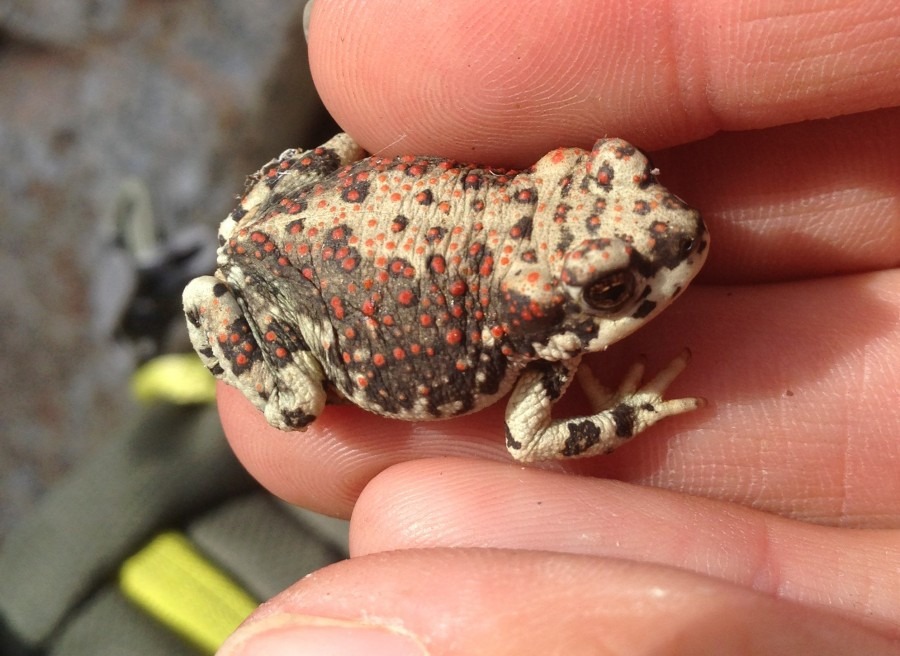
One of the charismatic plants of the area is the cacachila (Karwinskia humboldtiana; syn. Rhamnus humboldtiana) for which the mountain range is named. It is a member of the Rhamnaceae, the Buckthorn family, and has very distinctive veins on the underside of the leaves. In English it is known as the dot-n-dash plant for this unusual pattern that looks like Morse code. We scurry up steep scree slopes looking for plants we haven’t yet collected. The pickings are slim but include some ferns and small annual plants. I spotted several caterpillars and lizards and started to wonder if I was really in the right profession. Entomology looks like a lot of fun, and they don’t seem to have to hike nearly as far!

Nov 1st, Day 12, Friday: LA MALA MUJER
Today we decided to go another hike to the high elevation to look for species that aren’t lower down. It was a lovely hike, on open cow paths, and hot but not sweltering. We were joined by geologist Steve Reynolds who gave us fresh perspective on the landscape. I didn’t manage to look carefully where I was going and made the mistake of brushing past a plant of la mala mujer (Cnidoscolus maculatus) which translates to “the bad woman.” It’s a spiny plant in the spurge family (Euphorbiaceae) that has nasty stinging hairs that went right through my trouser leg, causing a burning sensation all down my calf. I asked if anyone knew of a plant that might take away some of the pain with its sap, but to no avail. At the top, as I rested on a rock enjoying the view, a cinche came and bit that same injured leg! To counter my bad luck, though, I had the good luck of finding a big gopher snake in a tree, and we took some photos with global positioning system data for the herpetology crew.


Another plant in the spurge family, this one reminding me of my brother, was the Mexican jumping bean or yerba de la flecha (Sebastiania bilocularis). One of my brother’s middle names is Sebastian, and I think he likes Mexican jumping beans! This tree has very attractive foliage but is actually quite poisonous, and it is rumored to be dangerous to sleep under it as the sap can make you go blind. The jumping beans are formed when a small predatory moth lays its eggs in the beans, and as the larva develop inside, moving around to avoid the heat, they cause the beans to wriggle or “jump.” As we came back down the path we could see the traps set-up along the trail by the entomologists. Hopefully they will make some great finds here.
Nov 2nd, Day 13, Saturday: ANT NESTS
Luckily this morning I had the where-with-all to check for scorpions in my boots before putting them on. There were no scorpions, but there was an enormous colony of ants that has set up shop overnight in my left boot! Curator of entomology Michael Wall came to my rescue and sprayed the boot with pesticide, and as I walked around in my socks, I was stung on the foot by a honeybee! There was much speculation that I had somehow offended the insect world.

Dr. Jose Luis Leon de la Luz from CIBNOR came to meet with us in the morning, and we discussed our more interesting collections so far. Amazingly, the Senecio-like plant (Asteraceae) we collected appears to be the first-ever collection from the cape region. I took advantage of an opportunity to hand-wash some clothes in a stone sink and reflected on the wonder of the washing machine. It’s amazing to think how much time and effort it would really take to wash a family’s clothes in this manner every day. Last night I took a bucket shower and felt like a real princess when my friend Alan brought me a second bucket of hot water! Living simply is a great reminder of how privileged we are in the city.
The bee sting and the medicine knocked me out for a bit, and in the afternoon I went to see what other museum curators and their teams had found. The reptile crew had a fascinating array of snakes, lizards, and toads, the bat team had 5 different bat species (with over 1000 bats living in an abandoned mine), and the rodent people had just caught a very cute shrew that bit me twice when I attempted to make contact! The botany team was joined by Dr. Jose Delgadillo from the UABC in Ensenada, and together we pressed plants (safely) into the night.


Nov 3rd, Day 14, Sunday: THE MULA MIL IN THE RAIN
When I woke up this morning we were all wondering how much it was going to rain. Reports had varied from 14-165 mm (0.5-6.5 in) of rain expected today. Since it wasn’t going to be a very productive field day in that sort of weather, Dr. Alan Harper and I headed south to the historic town of San Jose del Cabo where our friends from La Mula Mil (“The Mule 1000”) were kicking off their adventure. It was my first time passing through this region and seeing the Sierra Laguna and the hills and valleys of tropical vegetation. There were amazing clouds throughout our rainy drive, and when we arrived at the rodeo grounds to see the mule expedition folks on their way, they were in two minds about setting out into the storm. The amazing all-woman team was well-equipped, and local guide Chema Arce had their animals ready to go. A local priest came and blessed participants and riders. Since I am hoping to join the ladies for some of the more remote stretches of their journey, I was glad to finalize some logistical details and meet some of the other riders.
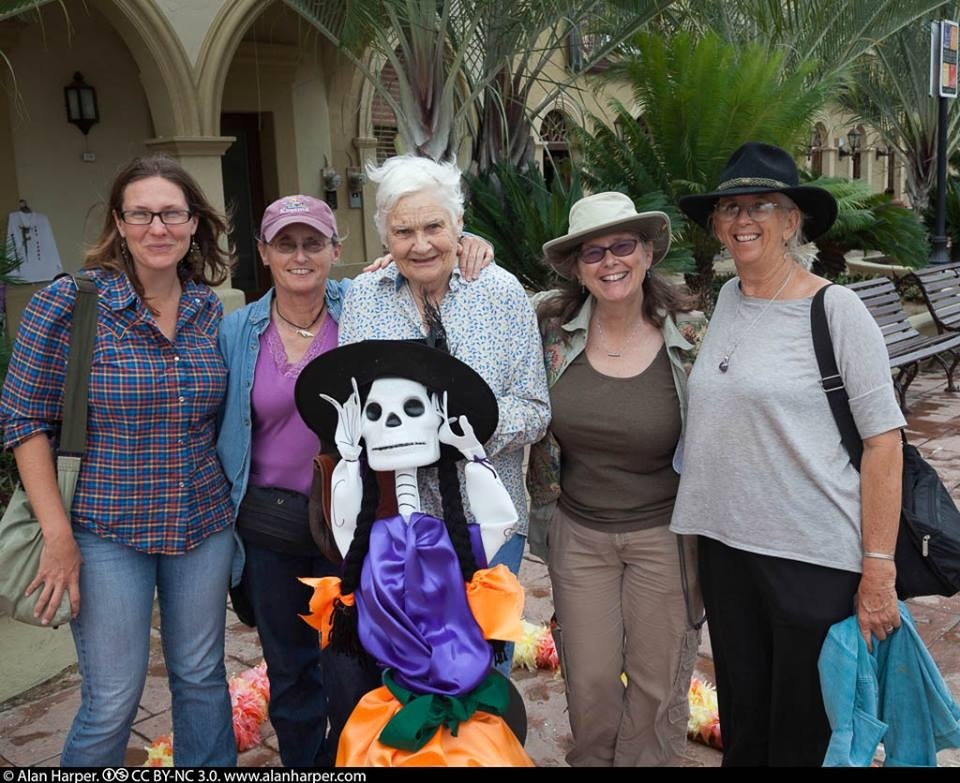
Eve Ewing, 85 years young, was joining the first stretch of this trip. Eve was on this expedition the last time it ran the length of the peninsula, 50 years ago. That time it went from north to south, and botanist Reid Moran was able to accompany them for almost 4 months of the trip. Eve told fascinating stories of the plants and plant communities they saw, bringing the route and the trip to life for me before they even set-off. If you would like to help send these woman on their way (or send me with them for a few more days!) they have an Indigogo fundraising site, where they have already raised almost $10,000 in support of their venture. Back at camp our colleagues had managed to botanize the beach a little and had found a fascinating Dutchman’s pipe (Aristolochia) in the sand. I was sorry to have missed such an exciting find and hope we’ll get another opportunity to see it. There was a giant scorpion in the bathroom tonight, and I think I need to remember to wear my shoes more often.

Nov 4th, Day 15, Monday: MINE-O-MINE!
I woke to the excitement of my roommate, Jim Riley, who had flown in from Orange County, California. He spoke of how overwhelming it is to be surrounded by such amazing taxonomists and specialists as Jon Rebman and the other curators, and we both reflected on how inspired we are by the rich natural history of the area and the amazing ability of some individuals to know every species they encounter.
This morning we headed a long way down a dirt road to a canyon, making a few stops to look at the geology and fault lines. Interestingly, the plant communities on the fault lines appear to be quite different, perhaps in part due to the altered hydrology, and in part as a result of the increase in clay in these soils. Finally we stopped at an abandoned mine and were led down the shaft by the mine manager. There were no plants there in the darkness, but our headlights soon revealed treasures amongst the overwhelming numbers of cockroaches! There was a mouse on her nest and what might be a new species of large cave spider (according to arachnologist Jim Berrian). Going deeper into the mine shaft we found the bats, and bat expert Drew Stokes caught a lesser long-nosed bat. Federally endangered in the US, these bats have found haven here in these man-made caves.

We then dropped into the canyon looking for plants–particularly, ferns. There were several endemic palm trees including Brahea brandegeei (Arecaceae), which is found only in Baja California Sur. In the evening I left the botany team to join Anny Peralta, Brad Hollingsworth, and the herpetology team for a night search. We turned over all sorts of rocks and logs, and finally, under a piece of wood, we saw what looked like a clump of scales. It turned out to be a Baja California spiny lizard (Sceloporus zosteromus) that was completely buried in the sand!

Nov 5th, Day 16, Tuesday:
Today the large botany entourage, accompanied by two mammologists from CIBNOR (Evelyn Rios and Eduardo Aguilera) and a birder (Gorgonio Ruiz) from UABC, went to Rancho Las Cruces. We took a long hike up a beautiful canyon with permanent water sources, stopping at an area known as the “7 pools” – seven permanent, deep pools of clear water that were perfect for swimming after hours of arduous bouldering to reach the area. We were in search of a fern, recently collected in the area but not recognized, and appearing to be either a new species or intergeneric hybrid. Sadly, despite eight sets of keen botanically-focused eyes, we didn’t encounter a single plant. The mammal team also struck out, catching zero chipmunks, so the winner of the day was Gorgonio, who managed to at least photograph a few birds! That said, one of the pools did yield an absolutely enormous shrimp that was quite a surprise, and John LaGrange carried it back with us in his backpack.

Nov 6th, Day 17, Wednesday:
Work is building up and so my blogs are getting shorter. Today we went to Presa de la Buena Mujer, a giant dam, with our fantastic guide Remigio. Last field day for this trip.
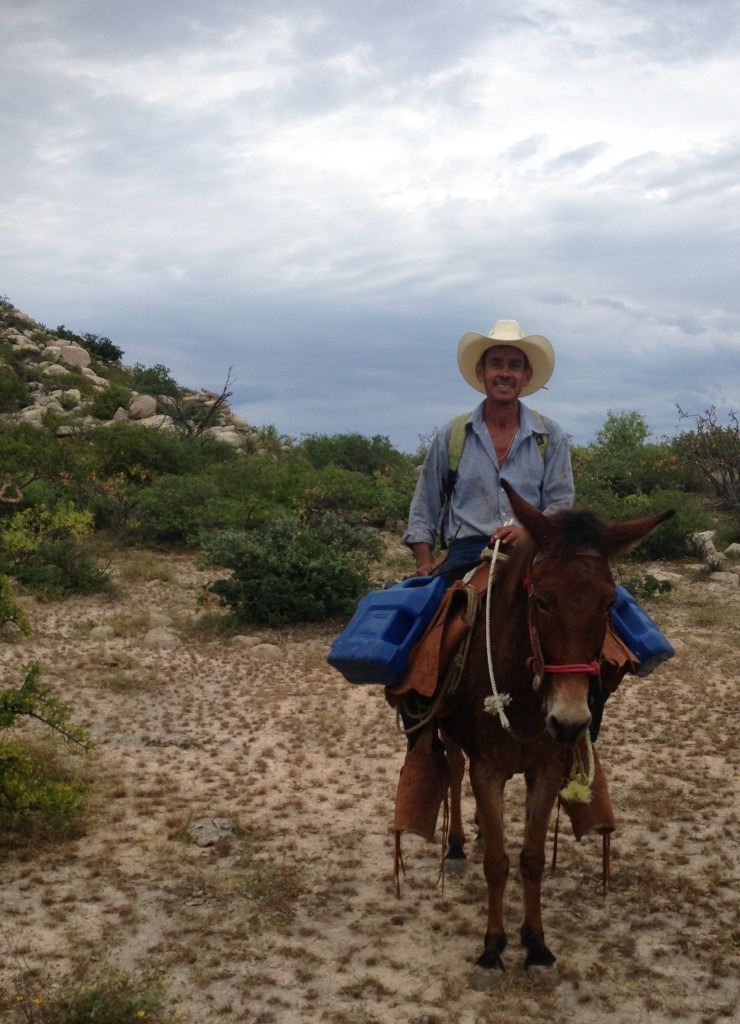
Nov 7th, Day 18, Thursday:
Rain today, so passing the time by preparing and planning for the next trip. Plus working on specimens, changing paper, presses…
Nov 8th, Day 19, Friday:
Rancho Las Cruces for breakfast, and now I am heading off to Cabo Pulmo. I have a 6-gear rental jeep that I have no idea how to drive properly and a month’s salary in cash strapped around my waist. Heart in my mouth, heading off into the sand dunes… Goodbye, world!!
Check out the video below about the expedition!
(Dr. Vanderplank’s part is right at the beginning!)
Sierra de las Cacachilas – Binational Exploration from San Mateo Creek Conservancy on Vimeo.





